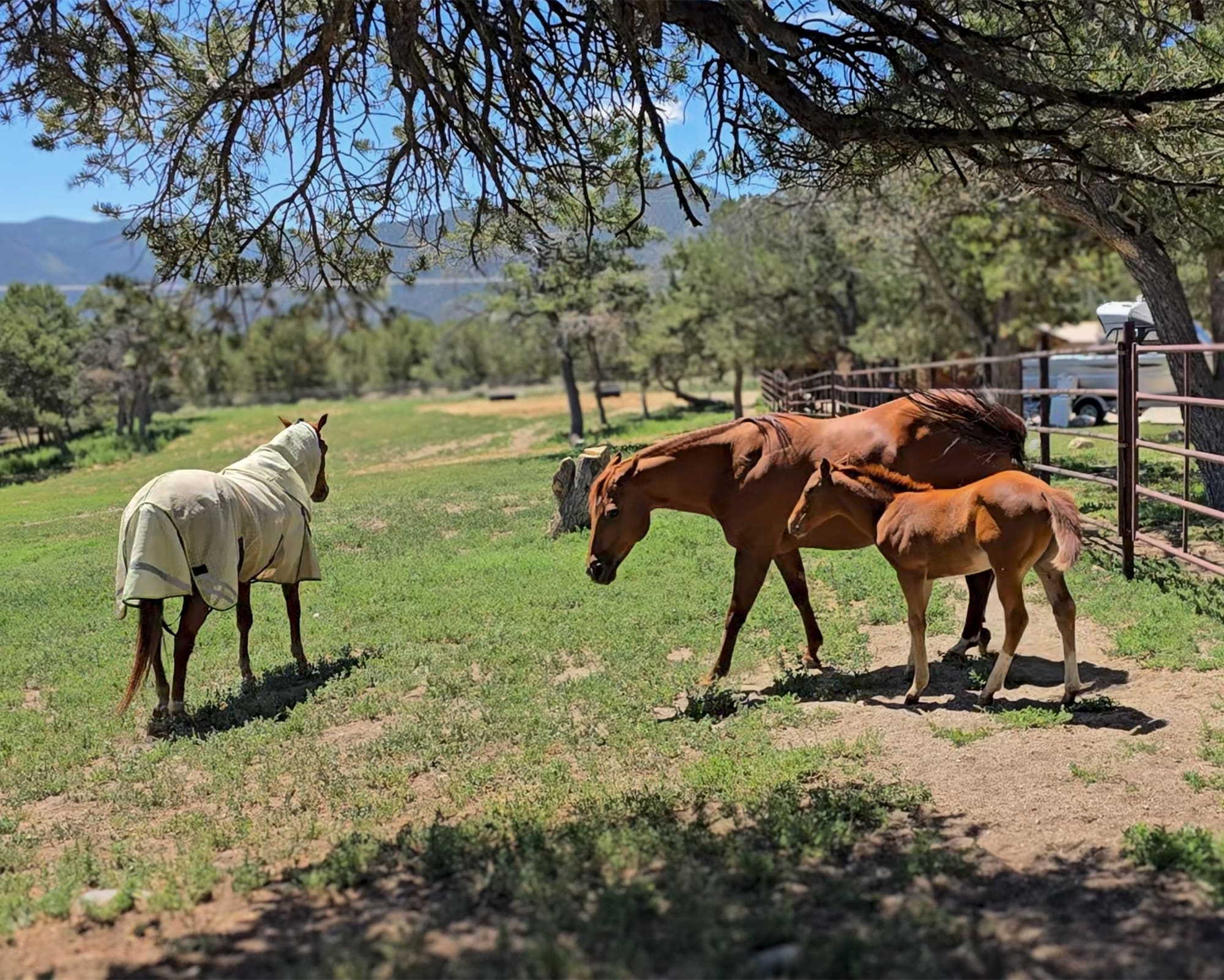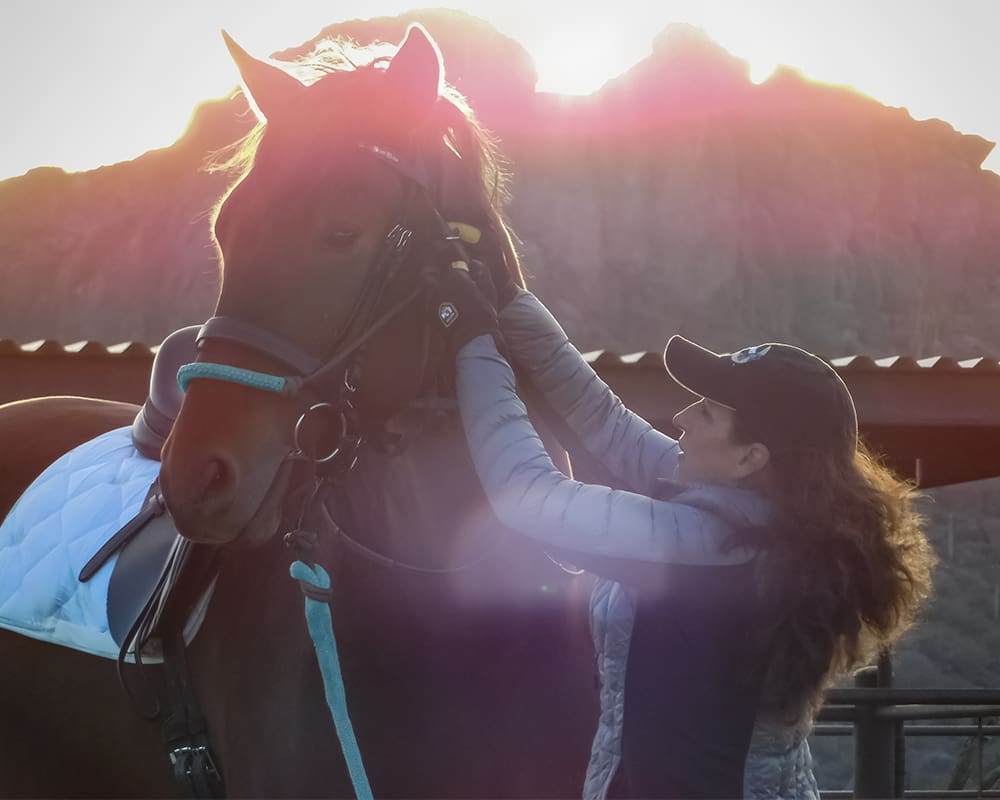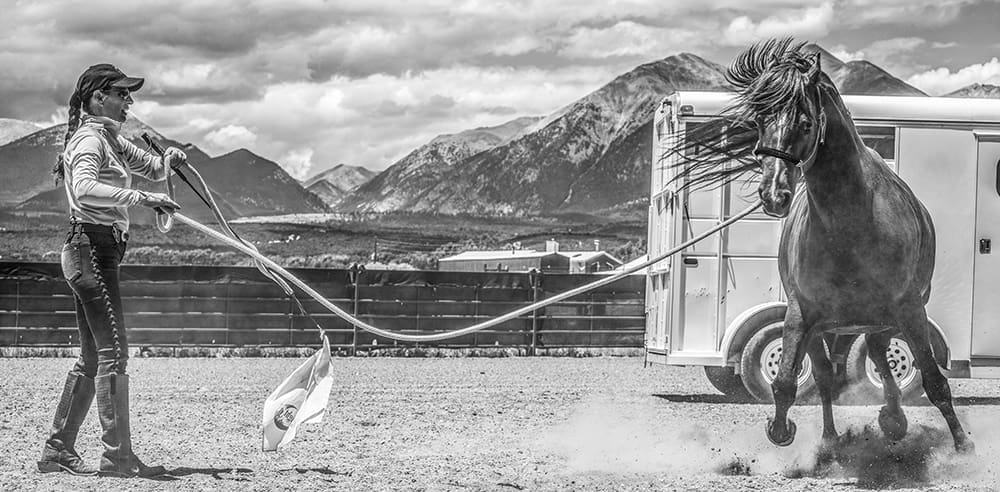When folks tell me about problem behaviors, I hear one phrase often. I admit I’ve even said it myself when I was a young trainer. “For no apparent reason, my horse….” You can fill in the next part with any frightening horse behavior. Choose from a list such as: bucked me off, kicked me, bit me, ran away, spooked, refused to get in the trailer, refused to go in the arena, reared. The list of behaviors that follows this phrase is long.
This one little phrase—for no apparent reason—seems to absolve the human of all responsibility. Surely the horse was to blame for his unexpected reaction. The phrase implies that there’s something wrong with the horse’s behavior. But there’s an important word buried within this phrase: apparent. Just because the human doesn’t yet know what caused the behavior, doesn’t mean the horse didn’t sense something real. It wasn’t apparent to the handler, but the horse knows what caused the behavior. It’s our job as horsemen to find out what was apparent to the horse.
Behaviors Have Purpose
All behaviors have a reason or purpose. There is always some purpose or meaning behind the behavior that a horse displays. It doesn’t always seem purposeful to us, but it is to the horse. You cannot watch a horse more than a minute without seeing behaviors.
Let’s get this fact straight: just because we do not like a horse’s behavior doesn’t mean that it is a bad behavior. For instance, a horse that kicks is not a bad horse; he’s a horse—they all kick. Horses may kick when they are startled or feeling the need to defend their space—or to ward off a predator. Or it may be an aggressive move to gain dominance. Kicking does not make him a bad horse and it is not a bad behavior from the horse’s point of view. He actually finds it quite useful. It’s just a behavior we humans don’t like, so we think of it as bad.
There should not be any value judgment when observing a behavior. Behaviors that are undesirable to us humans are not bad they just are. The challenge we as horse people have, is to promote the behaviors we want and try to eliminate, or extinguish the behaviors that are undesirable, unsafe or unmanageable– not to get caught up in the horse’s drama and react in an emotional way or take his behavior personally.
I talk a lot in my clinics about horse training—teaching the horse manners, cues, obedience and responsiveness. We are all horse trainers—anytime you interact with a horse, you are either training him or un-training him. It’s just that some people are better at training –or promoting the good behaviors– than others.
Find the Motivation
To me, after a half-century of training horses, the most effective way to have an impact is to first understand the natural and instinctive behaviors of horses. Then try to understand the motivation for the specific behavior. Only once you have an idea of the motivation, employ well-known, science-based training techniques that are proven to be effective (such as classical conditioning, operant conditioning, negative and positive reinforcers, replacement training vs. punishment, finding the amount of pressure needed to motivate change, etc.). If you understand the behavior first, you’ll see that it doesn’t come “out of the blue.” You’ll think of reasons that may have caused the behavior and choose your plan to teach the horse to act another way.
You will always be more effective in changing a horse’s behavior if you can understand the origins of that behavior: is it instinctive or learned behavior; how is the horse benefitting from this behavior; how motivated is he in this behavior; and how engrained or habitual is the behavior (how long has he been doing this)? These answers are sometimes hard to know, but the more you understand about the horse’s behavior, the easier it is to affect change.
Calm and Carry On
Noticing the horse’s body language and state of mind can only happen if you’re calm and paying attention. There is often a mystique around some horse handler’s ability to “read” the horse. You know, some people are nicknamed “horse whisperers.” But reading a horse and understanding his language doesn’t have to be confusing or mystical. If you understand the communicative language of horses (they speak through postures and gestures), they are actually pretty transparent. But you do have to be aware and pay attention. Even a person that has no experience with horses ought to be able to look at one and tell you whether it is relaxed or nervous, attentive or distracted, agitated or content. The information is there—all you have to do is observe and think about what the horse may be sensing.
But keep in mind that because they are herd animals–and prey–they are hard-wired to take on the emotions of the other animals in the herd—and that includes you! If one animal becomes frightened—all the horses in the herd will tend to respond the same way. So when things get tough, it is incredibly important that we humans try to keep our emotions in check. No matter how you feel on the inside (scared, angry, frustrated) keep your body language and emotions in check and remain calm. No need to throw gas on the fire.
Instincts Rule
Recently, the results of scientific research into horse behavior proved something that horsemen have known for centuries. Horses are prey animals and as such, they instinctively hide their pain. Think about it—which horse gets eaten first by the predator? It’s the one in the back of the herd—the slowest, sickest or lamest horse. Horses don’t want to show pain if they can mask it because showing pain shows weakness. This one fact of life explains a lot about horses.
Some horses have a very high threshold of pain and will mask any discomfort they feel (while others, like my horse Dually, will let you know if a hair is out of place). That means it is up to us to become the investigator, to know each horse as an individual, and also we have the responsibility to address every problem as a pain issue first, and rule out any possible physical cause for undesirable behavior before we address it as a training issue. After more than three decades of training horses, I can tell you that more “training problems” originate from physical problems than most people realize.
Also, related to this same instinct, is the horrific instinctive fear that most horses have about being left behind. If you only have two horses at home and you take one out of the pen to ride, it is the horse that is left behind that throws a fit. If you try to hold your horse back in a group trail ride while the others gallop off into the sunset, you are picking a huge fight with your horse that you may not win. The horse’s desire for safety and to be part of the herd is strong.
Horses are herd-bound according to their instinct—it is called gregarious behavior. They simply want to be friendly and be around the herd. Yet we tend to speak of herd-bound, barn-sour behavior as an affliction. The behavior is deemed bad by humans, but it’s simply a typical horse behavior. It is a simple fact of horsemanship that unless and until the horse gets the same sense of security and comfort from you that he gets from the herd, he is not going to want to leave with you. It is not the horse’s affliction—it is your lack of leadership and authority that is at issue; you have to change, not the horse.
Listen to the Horses
We owe it to our horses to understand their behavior and learn more about effective training techniques and to be the strong leader that they need, including accepting responsibility for our own actions or failures. Nothing happens “out of the blue.” Nothing happens “for no apparent reason.” The horses are telling us something with their behavior and we need to help them by finding out what doesn’t feel right.
A great example of this concept happened at one of the shoots for my TV show. In this instance, it would have been easy to blame the horse, but he indeed had something to tell us. His behavior only seemed “out of the blue.”
Several of us were fussing with a horse to get him ready for the segment we were taping (wiping his nose, adjusting the tack, checking the microphone on the rider, etc.). Several people rushing around a horse at one time is a recipe for disaster indeed. But this was a horse we knew and he’s known to have a calm and accepting attitude. Still, it’s just too easy to not notice something that you would see if you were the only one checking tack and doing all in a slow, intricate order. We were saddling the horse with brand new tack—fixing the cinches, adjusting all of the new leather. In the mix and chaos, one of my crewmembers was suddenly kicked.
Some may have said the horse’s kick was “for no apparent reason.” It did seem out of the blue for this horse. But a little investigating showed us it was us humans, not the horse who needed a lesson. As it turns out, the new saddle we placed on the horse had a back cinch that wasn’t connected to the front. In the chaos and hurry, we hadn’t noticed that the hobble had come untied. The back cinch slid back to an uncomfortable position for the horse. It was in the position of a bucking strap! To the horse, the reason for his behavior was obvious. His kick was a behavior to get that out of his space.
Later that evening, my crewmember called his wife—who happens to be a horse trainer. He told her he had gotten kicked. I’m sure he was expecting her to say, “OMG, are you ok?” Instead, her response was, “What did you do to the horse to make him kick you?” (A woman after my own heart!) The fault was with us humans. What wasn’t apparent to us was apparent to the horse. And we now have practices in place to make sure that we slow down and check details instead of being in such a rush to hit record. Only two crew members attending to a horse at any given time. It was a lesson for us to learn. Slow down, notice, and think about what the horse is experiencing.
We, as humans, must accept responsibility for understanding horses better. We must think about why and how our interactions with horses work or don’t work. Horses will never study human behavior or effective training techniques. It’s our job to learn about them. Embrace it—horsemanship is a journey— and the more you learn, the more rewarding it becomes!
Enjoy the ride,
Julie



